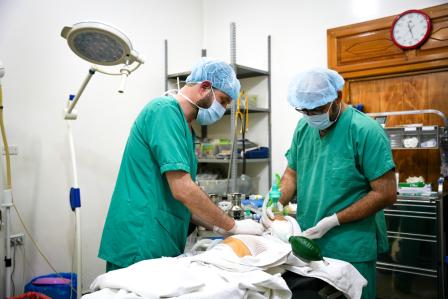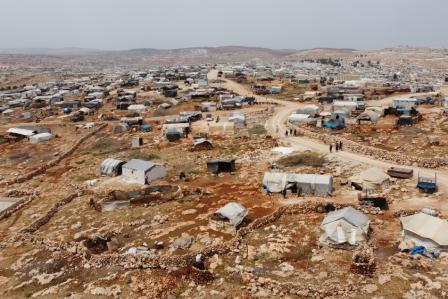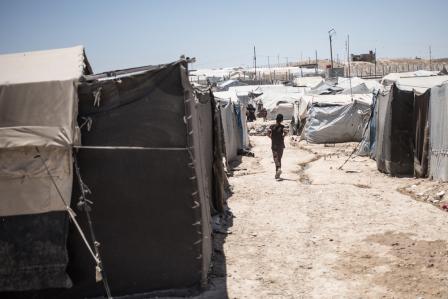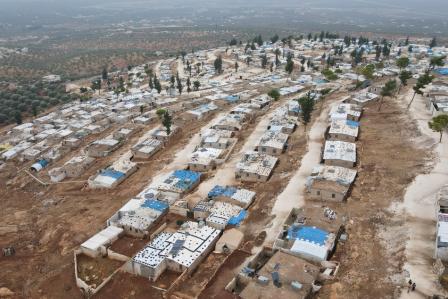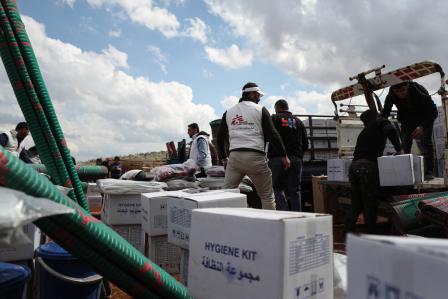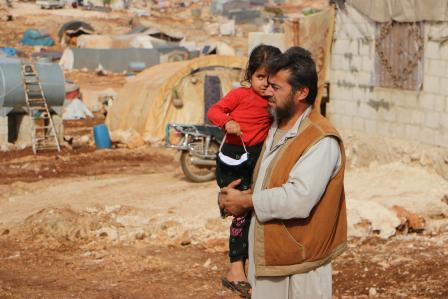Northeast Syria: 'The feeling that hangs in the air’
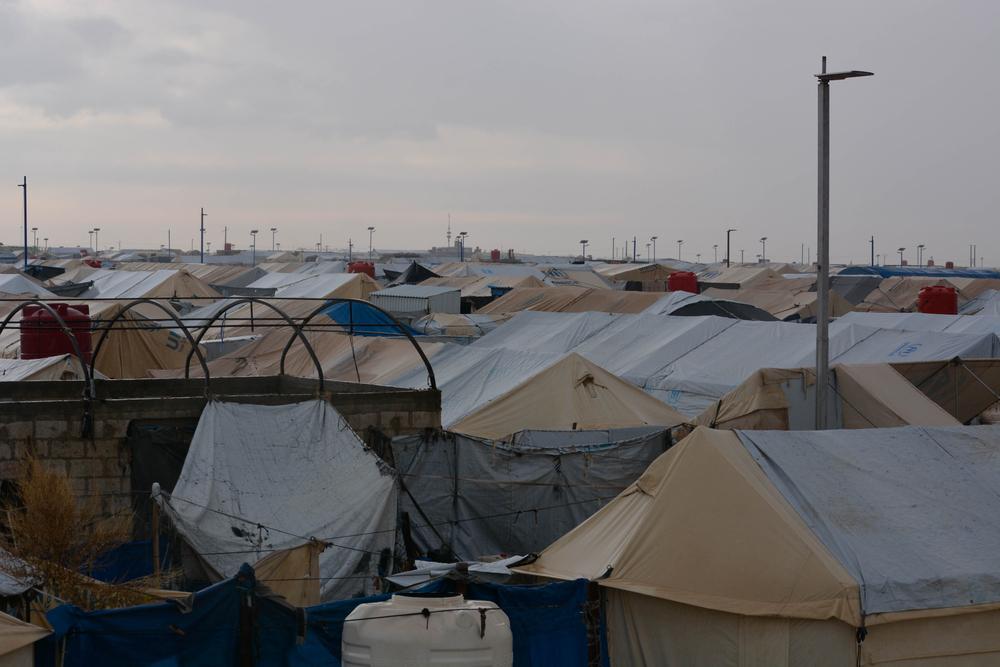
A view of Al-Hol camp in Northeast Syria. Syria, December 2023. © MSF
Vickie Hawkins is Doctors Without Borders Netherlands General Director who recently returned from a visit to Northeast Syria. She shares her experience after visiting Doctors Without Borders projects there and the horrific situation facing the people:
In 25 years working at Doctors Without Borders / Médecins Sans Frontières (MSF), I have often been asked what are some of the things I’ve seen through my work that have really stuck with me. Sometimes there is a stand-out experience or person. But what’s harder to explain is that sometimes what stands out is a feeling, something in the air that you can’t quite explain. Which is definitely the case for my recent visit to our programs in Northeast Syria (NES).
In NES, our teams provide primary healthcare, treatment for non-communicable diseases (NCD) like diabetes and heart disease, and run a water purification plant to provide safe drinking water in Al-Hol camp. Our medical teams also provide care in Al-Hol camp for people who are unable to reach clinics.
NES exists in a web of complex geopolitical forces. Wedged in between neighboring Turkey and Iraq, governed autonomously from the rest of Syria, these lines of control buzz with frictions whirling above the heads of the approximately more than 3 million people who reside there.
Life in an open-air prison
One of the first stops during my visit was Al-Hol Camp, a massive detention camp on the southern outskirts of Al-Hol town, close to the Syria-Iraq border. It’s here that more than 43,000 people are detained in what is effectively an outdoor prison made up of tents with a huge fence and a scattering of armed guards around the perimeter.
As the temperature surged above 40 degrees celsius, I wondered how it was possible to endure the heat and the dust, living in a tent, for years on end. I had read and heard a lot about Al-Hol camp before visiting, but when you see it firsthand, you realise how incredibly unforgiving it is, a restricted context within another restricted context.
The camp originally provided temporary accommodation and humanitarian services to people displaced by the conflict in Syria and Iraq. However, it has increasingly descended into an unsafe and unsanitary open-air prison after people were moved there from Islamic State (IS) controlled territories in December 2018.
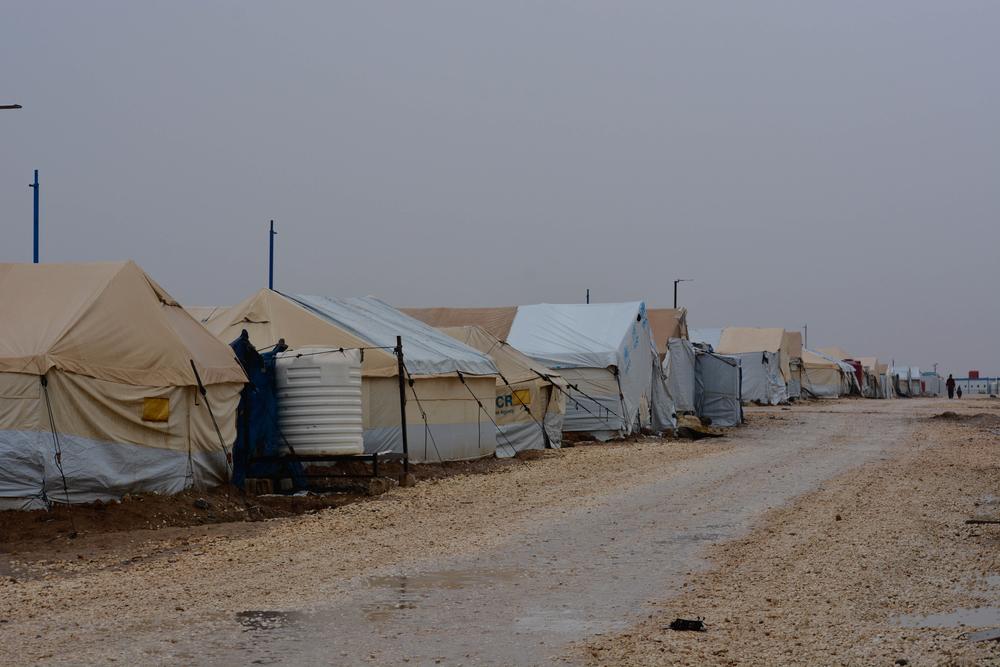
A cluster of tents close to Doctors Without Borders' facility, on a rainy day at Al-Hol camp, northeast Syria. Syria, December 2023. © MSF
Since that time, the people in the camp have effectively been trapped in limbo, with only a trickle of the detainees having been returned to their countries of origin including France, Canada, Australia, Syria and Iraq. Walking through the camp, what stood out to me was the sheer number of children there. A staggering 65 percent of people at the camp are under the age of 18 and 51 percent are under the age of 12.
As you enter the camp, you see children playing in the dirt with makeshift toys crafted from garbage. They don’t have regular access to education or social activities. As you watched them try to while away the time, it was clear that this is no way for anyone to be forced to live, let alone children.
I couldn’t help but wonder what kind of future there is for these kids, trapped in the middle of violence and desperation. For years we have documented the unsafe conditions in Al-Hol and yet, over five years later, things remain eerily the same. In fact, in the weeks after I left NES, there was another violent raid by security forces.
In the early hours of the morning on Monday, June 10, tents were slashed, people were physically assaulted including a woman and a child who were treated for injuries in our camp clinic, personal belongings were destroyed, and nine children were separated and removed from their distraught mothers. These women have still not been provided information about the whereabouts of their children.
Boys aged 12 and above are routinely removed and placed in detention centres outside the camp with little to no contact or oversight from the outside world. The recent so called ‘security operations’ followed a similarly violent raid on January 29, during which tents were ransacked, people were beaten, and at least one child and one woman died, while several others were injured.
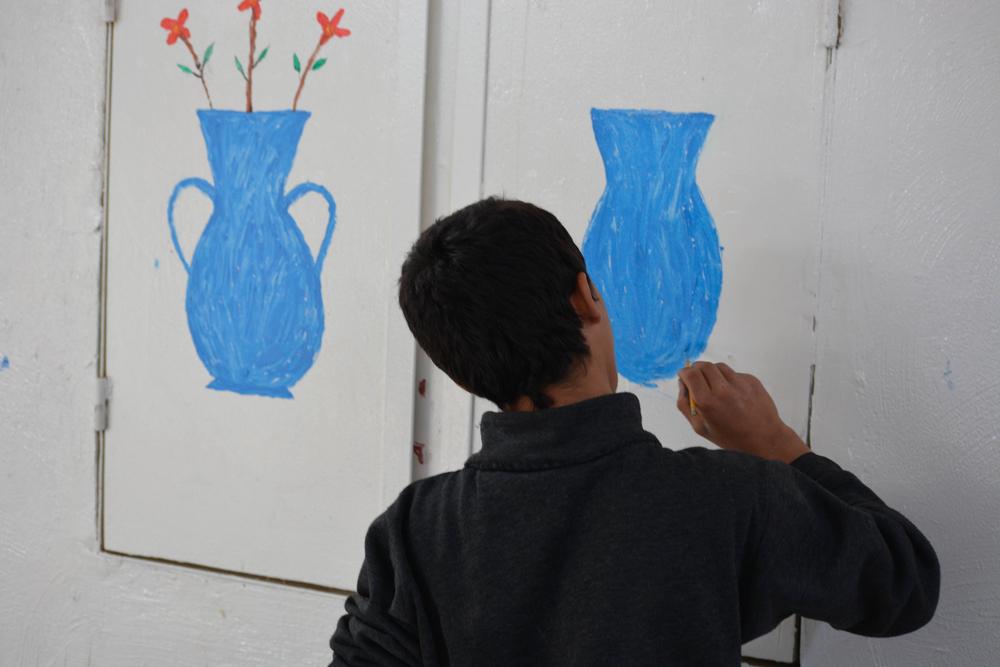
A teenager clinic drawing on the wall at a Doctors Without Borders mental health at Al-Hol camp, northeast Syria. Syria, December 2023. © MSF
Just days later, when I visited our programs in the cities of Raqqa and Hassakeh, I began to understand that the desperation in NES is not limited to Al-Hol. Across NES the gaps in services are clear. I visited our teams who support a primary healthcare centre, run a therapeutic feeding program for malnourished children, run two clinics treating NCDs, and respond to outbreaks of diseases including cholera and measles.
In the Hassakeh city NCD program there are nearly 3000 patients while the Raqqa NCD program supports over 2800 patients.Seeing these initiatives, and speaking with patients, it was clear how the economic crisis in Syria, on top of everything people have experienced during over a decade of conflict, has now really hit.
I heard stories about having to make seemingly impossible choices and spoke to people who told me that they rely on Doctors Without Borders' free services because they simply cannot afford to pay for healthcare. For some, it would mean deciding between putting food on the table for their families or buying medicines for their chronic condition.
I spoke to people in mourning for everything that has disappeared in what seemed like the blink of an eye. Prior to 2011, Syria had a well-developed healthcare system, but speaking with people in NES, I got the sense that they felt trapped in this small corner of the country, unable to cross borders or to see any future beyond the day-to-day.
The data unfortunately proves it. Whilst I was in NES, the 2024 donor conference for Syria took place, and resulted in a 20% reduction of donor funding for humanitarian programs across Syria. This is the second year in a row of reductions. When you consider that in 2024, US$4.07 billion is required to respond to humanitarian needs in Syria but just six per cent, or $326 million, has been funded through the Humanitarian Response Plan (HRP), it’s easy to see how paralysing the situation is, with interest and support waning.
In Al-Hol camp, for example, the needs couldn’t be any more pressing: in March of this year, the World Health Organization (WHO)-funded medical referral system from 11 camps, including Al-Hol, ceased due to lack of funding. This funding cut essentially eliminates the possibility for people in Al-Hol camp, and from other camps in northeast Syria, to access specialist healthcare, including for treatable and preventable diseases, and for urgent specialist care like surgery.
An unprecedented water scarcity crisis
Along with the economic crisis and food and medical supply issues, NES is facing an unprecedented water scarcity crisis. Reduced rainfall, severe drought conditions combined with low water levels in the Euphrates River, interruptions to supply from the Alouk water station that used to serve over a million people, and damaged water infrastructure have not only deprived millions of Syrians of safe drinking water but have also resulted in further inflation and harvest and income losses.
This increases the risk that outbreaks of diseases such as cholera, measles and respiratory infections can spread rapidly. I heard from Doctors Without Borders teams and from patients about how urgent action is needed to strengthen epidemic preparedness in NES, improve healthcare access, and ensure sustainable access to clean water to prevent and limit the impact of outbreaks.
It's a place where the international community still has a huge part to play in providing humanitarian assistance. This is particularly true in Al-Hol Camp, where the Autonomous Administration of North and East Syria, the US-led Global Coalition to Defeat ISIS, international donors, and countries with citizens detained in Al-Hol must urgently provide a long-term solution for people detained in the camp.
Whilst the Syrian conflict has abated, there is a perpetual sense of the potential for escalation. This is the feeling, the thing that is hanging in the air. And it compounds the significant trauma that has already been experienced by the people in NES, as they remain essentially trapped and vulnerable, awaiting whatever comes next.
